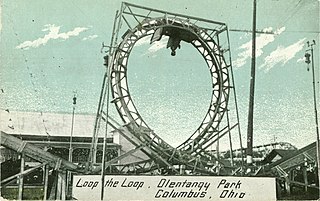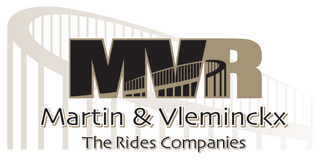
A wooden roller coaster is a type of roller coaster classified by its wooden track, which consists of running rails made of flat steel strips mounted on laminated wood. The support structure is also typically made of wood, but may also be made of steel lattice or truss, which has no bearing on a wooden coaster's classification. The type of wood often selected in the construction of wooden coasters worldwide is southern yellow pine, which grows abundantly in the southern United States, due to its density and adherence to different forms of pressure treatment.

Philadelphia Toboggan Coasters (PTC) is one of the oldest existing roller coaster manufacturing companies in the world. Based in Hatfield, Pennsylvania, it was established in 1904 by Henry Auchey and Chester Albright under the name Philadelphia Toboggan Company. The company manufactured carousels, wooden roller coasters, toboggans and later, roller coaster trains.
Anton Schwarzkopf was a German engineer who founded Schwarzkopf Industries GmbH, a German manufacturer of roller coasters and other amusement rides that were sold to amusement parks and travelling funfairs around the world.

A hypercoaster can mean one of two things:
John A. Miller was an American roller coaster designer and builder, inventor, and businessman. Miller patented over 100 key roller coaster components, and is widely considered the "father of the modern high-speed roller coaster." During his lifetime, he participated in the design of approximately 150 coasters and was a key business partner and mentor to other well-known roller coaster designers, Harry C. Baker and John C. Allen.

The Allan Herschell Company specialized in the creation of amusement rides, particularly carousels and roller coasters. The company manufactured portable machines that could be used by traveling carnival operators. It was started in 1915 in the town of North Tonawanda, just outside Buffalo, New York, USA.

Chance Rides Manufacturing is a roller coaster and amusement ride manufacturer. The company was formed on May 16, 2002, when the former Chance Industries Inc. emerged from bankruptcy. The main office and manufacturing facility are located in Wichita, Kansas.

F.lli Pinfari S.r.l was an Italian amusement ride manufacturing company based in Suzzara, Italy. Pinfari was liquidated on 15 July 2004, due to the early 2000s recession and the weakness of the United States dollar. In 2007, its brand and intellectual property were acquired by Interpark Amusements Srl, based in Modena.

Shuttle Loop is a type of steel launched shuttle roller coaster designed by Reinhold Spieldiener of Intamin and manufactured by Anton Schwarzkopf. A total of 12 installations were produced between 1977 and 1982. These 12 installations have been located in a total of 22 different amusement parks.

The Cyclone was a wooden roller coaster that operated at Revere Beach in Revere, Massachusetts, from 1925 until 1969. When Cyclone was constructed, it was the tallest roller coaster ever built, as well as being the first roller coaster in the world to reach 100 feet (30 m) in height. In addition to being the tallest roller coaster of its day, some also claim that it was the largest and fastest roller coaster in the world, with a length of 3,600 feet (1,100 m) and top speeds between 45 and 50 mph. Cyclone held the title of world's tallest roller coaster until 1964 when it was surpassed by Montaña Rusa at La Feria Chapultepec Mágico in Mexico City, Mexico.

Rocky Mountain Construction, often abbreviated as RMC, is a manufacturing and construction company based in Hayden, Idaho, United States. The company is best known for its I-Box track and Topper Track for wooden roller coasters.
This is a list of events and openings related to amusement parks that occurred in 2013. These various lists are not exhaustive.
E&F Miler Industries is a family-owned roller coaster manufacturing firm based in Portland, Oregon, United States. The company specialises in smaller children's roller coasters; however, it has manufactured some larger family roller coasters in the past.

Loop the Loop was an early looping steel roller coaster which operated at Olentangy Park in Columbus, Ohio during the first decade of the 1900s. It was one of the first looping roller coasters to operate in North America, and it was designed and built by noted inventor Lina Beecher.

Martin & Vleminckx is a roller coaster manufacturing and construction company headquartered in Montreal, Quebec, Canada with an affiliated office and manufacturing facility in Haines City, Florida, United States, and two subsidiaries, including a warehouse, in China.
B.A. Schiff & Associates was a roller coaster manufacturing firm based in Miami, Florida, United States. Founded by its namesake, Ben Schiff, the company produced family style roller coasters including a variety of kiddie roller coasters and Wild Mouse roller coasters. The company operated from approximately 1948 into the early 1970s.

The Sesquicentennial Cyclone was a steel-framed wooden roller coaster which was operated at the Philadelphia Sesquicentennial Exposition in 1926. Designed and built by Harry Traver of Traver Engineering, the coaster was a medium-sized prototype of Traver's later Giant Cyclone Safety Coasters.












